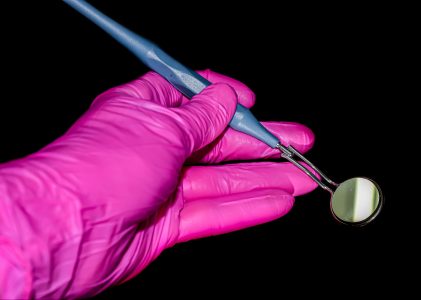Tooth loss
Tooth loss is an infectious disease that affects many in the population. It is based on an inflammation of the gums, and there are several symptoms to be aware of.
Tooth loss, periodontitis, is an infectious disease that affects the supporting tissues of the tooth. The disease is often based on gingivitis, which is a reversible condition, but with untreated periodontitis, the teeth can eventually become mobile and as a result loosen. At Aqua Dental, we have extensive experience in treating tooth loss diseases.
What is tooth loss?
Tooth loss begins as a gingivitis most often caused by plaque, bacterial deposits at the gum line. The inflammation fights the infection in the gums by breaking down the infected tissue. If this defense works, the tooth loss process can stop. If it does not work, or reacts too aggressively, the gum pockets will deepen.
The pockets thus become deeper and more complicated to clean on their own, which makes it easier for the bacteria to get a foothold. The inflammation can then spread along the tooth root, the root membrane and down into the jawbone. If the inflammation remains untreated, it can break down the braces, and the teeth can become mobile and fall out.

Symptoms of tooth loss
It is common for the dentist to detect tooth loss disease during a routine examination and for the patient to be alerted to the problem only then. As a patient, you can detect the disease yourself by the gums bleeding and one or more teeth becoming loose. There are some symptoms to be aware of, most often it is not the tooth loss disease but it is important to seek care to rule out dangerous diseases.
- Bleeding gums
- Bad breath for a long time
- Swollen and red gums
- Whitening around the teeth may occur
- Gums that pull up towards the root of the tooth
Do you need to find free time?
How does tooth loss feel?
Tooth decay does not hurt and those who suffer from the disease usually do not feel it. It is therefore important that you visit the dentist regularly so that any tooth loss diseases can be detected at an early stage.
Causes
The disease is caused by a bacterial coating that settles at the gum line and causes inflammation in the gums if the teeth are not cleaned daily. If the inflammation remains untreated, it can descend into the tooth’s supporting tissues, the jawbone, where it gradually breaks down the tooth’s attachment.
In most cases, the bacterial coating occurs as a result of inadequate daily cleaning of the teeth. In some people, there is also heredity that increases the tendency to develop tooth loss. According to research, other risk markers have shown that there is a link between tooth loss disease and diabetes, cardiovascular disease, certain types of cancer and smoking.
How long does tooth loss take?
The course of the disease before tooth loss usually lasts for several years. Through regular visits to the dental care, the dentist or dental hygienist can detect the disease at an early stage and then possibly start treatment before the tooth loss has time to become extensive.
This is how tooth loss is treated
It is possible to treat tooth loss and tooth loss diseases. In cases where the disease is detected at an early stage, particularly good results can be seen. If you have suffered tooth loss, the first step in treatment is a thorough clinical examination. The dentist or dental hygienist makes a pocket depth measurement and, if necessary, new X-rays are taken.
They go through all the teeth, measure gum pockets, note bleeding in the gums and if any teeth feel mobile. The information is used to assess each individual tooth and its state of health. That assessment forms the basis for the treatment plan.
The treatment is usually started by the dental hygienist going through how to take care of your daily cleaning of your teeth. You undergo motivational conversations and, if necessary, also guide the patient to quit smoking.
The treatment continues by the dentist or dental hygienist, under anesthesia, removing bacterial deposits and tartar in the gum pockets. In more severe cases, your regular dentist may refer you to a periodontist, a specialist dentist in periodontitis. In some cases, gum surgery may be needed, but also tooth extractions. It is also important with self-care to get as good a cure as possible.
The goal of the treatment
The goal of treatment is to stop the development of the disease. If the disease is detected in time, the treatment results are usually good. As periodontitis is a chronic infectious disease, it is important that the person affected by tooth loss also continues to go for regular check-ups and supportive treatments. This is done to intervene at an early stage if it is discovered that the disease is on its way back.
Is it possible to prevent tooth loss?
The easiest way to prevent tooth loss is to take care of your oral hygiene and to go to regular dental visits. Be sure to brush your teeth twice a day and use tools such as dental floss, toothpicks or spacer brushes to clean between your teeth. If you smoke, it is recommended to quit as it increases the risk of tooth loss, speeds up the course of the disease and impairs healing. Heredity for tooth loss can play a role but can often be counteracted by daily and thorough cleaning of the teeth.


